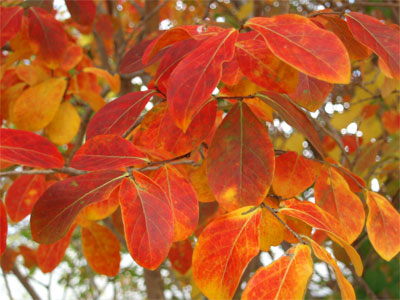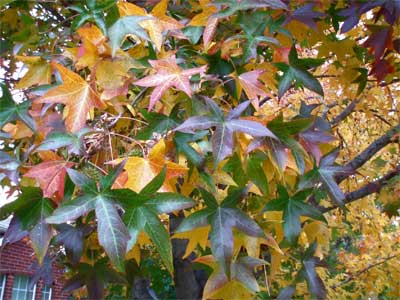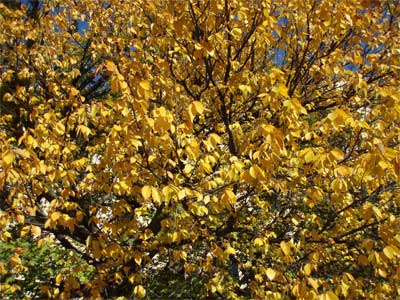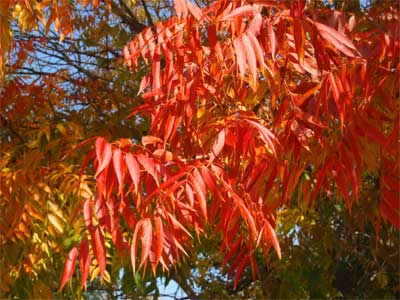Texas Tree Tips – November, 2012

While planted for their abundant summer flowers, many varieties of crape myrtles also provide dazzling fall foliage in shades of yellow, orange, red, and purple. Photos by Bill Seaman.
Texas Trees Pop with Fall Colors
Texas gardeners are fortunate in that our autumn weather plays out over a number of months, providing an extended period of fall color across the state. In the best of years, our displays can be spectacular as they begin in the north and move south. The first cool weather in the Panhandle may not reach the Rio Grande Valley for weeks. As the length of the days wanes, and temperatures drop, many Texas trees initiate a chemical process that brings out the best of fall colors.

Selected varieties of sweetgum trees develop fall color that includes individual leaves sporting individual colors. Green, yellow, orange, and mahogany leaves can be found growing on a single branch.
While the chemical reactions that result in yellow to crimson fall leaves may be complex, an understanding of the process is not needed to appreciate the autumn display of sweetgums in the Pineywoods or cottonwoods along the state’s western waterways.
Simply put, leaves change colors because the production of chlorophyll, the substance that makes leaves green, ceases. As the chlorophyll fades, other pigments that have been masked since spring are revealed. Xanthophylls and carotenoids produce the yellows in elms and the oranges in Chinese pistache. Anthocyanins form the reds in maples and the purples in Texas red oaks. When all the pigments have faded, only brown tannins remain.
Weather is a predominant factor in fall color. Drought stress can diminish brilliant hues. A hard freeze can quickly end complex chemical reactions. The most colorful falls occur when rainfall has been plentiful throughout the year and fall night temperatures are consistently cool. This variability helps us appreciate the current season and creates the anticipation for the autumns to come.

American elm trees are dependable producers of fall color. As a group, their bright yellow foliage is an indicator that the seasonal transition is beginning.
Fall color is an attribute that creates interest in any landscape. Texas gardeners can choose from a long list of reliable performers. Trees that produce the best yellows include cedar elm, American elm, cottonwood, and green ash. Our state tree, pecan, can produce dynamic yellows in the best of years. Ginkgo trees are prized for their butter yellow leaves that seem to drop in unison.

The vibrant orange fall color of Chinese pistache trees is one trait that makes this tree a garden favorite.
Chinese pistache produces brilliant orange foliage, closely followed by Texas ash. The Indian series of crape myrtles (‘Muskogee’, ‘Natchez’, ‘Yuma’, etc.) develop bold oranges, too. Bald cypress and pond cypress leaves can go through a transition of color that starts with yellow, moves to bronze, and ends with copper.
As a group, maples produce the best reds. Fortunately, there is a native or adapted maple for every region of the state. Bigtooth maple, the namesake tree of Lost Maples State Park, grows well in alkaline and thin soils. Red maple is planted as a canopy tree in the eastern third of Texas where the soils are sandy and acidic. No mention of fall color can be made without noting Japanese maples and the hundreds of selected cultivars. While ‘Bloodgood’ and ‘Burgundy Lace’ are longtime standards, more recent cultivars also provide spectacular colors. Other trees with notable red foliage include Shumard red oak and shining sumac.
A few trees are known for their mahogany to purple fall foliage. Texas red oak leaves are most frequently red to maroon; but occasionally there are years when the canopy foliage morphs to a dark purple before dropping to the ground. The glossy leaves of rusty blackhaw viburnum turn a rich mahogany, making this understory tree highly desirable, yet difficult to find in nurseries and garden centers.
If you need to add a punch of fall color to your landscape, look for the trees that color-up best in your area. Then, consult with your arborist or nurseryman to discuss the pros and cons of your short list. Make your selection, and plant now for fall color next year.
About the author: Bill Seaman is a sixth generation Texan, degreed horticulturist, and member of the certified arborist team at Arborilogical Services, Inc., “The Experts Your Trees Deserve.”
